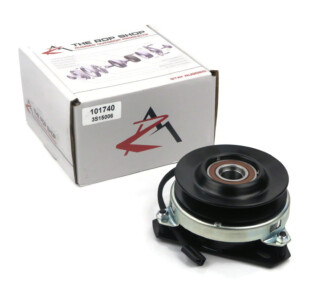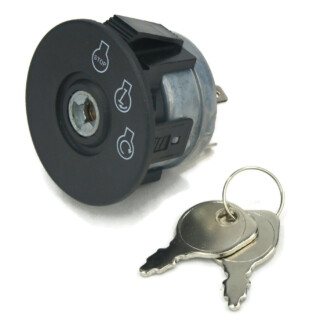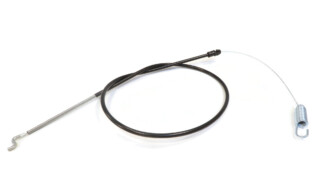
11 Mowing Safety Tips to Help You Avoid Disasters
It can be easy to think of mowing as just an everyday task and not take seriously the risks involved. However, when you think about it, there are a lot of components that can be dangerous: spinning blades, hot engines, and so on, not to mention that a lawnmower can weigh over 1,000 lbs.
Lawnmower injuries are by no means uncommon—or cheap. One study estimated that there were over 51,000 cases of lawnmower injuries in the US from 2006 to 2013. Furthermore, the average emergency room charge was estimated at over $2400 per patient, while the average inpatient charge was almost $37,000 per patient.1
This means that if you value your safety (and don’t have $30,000 or so lying around), you should take lawnmowers seriously.
At The ROP Shop, we want you to be ready to take on the outdoors, and we want you to be safe when you do it. We’ve put together this list of lawnmower safety practices to help you out.
Before we dive in, it’s worth mentioning that you should be able to find lawnmower safety information in your mower’s owner’s manual (as well as other helpful information about the care and use of your mower).
Wear necessary safety gear
Don’t treat lawnmowing just like any other Saturday afternoon chore. If you’re mowing, you should take the time to put on personal protective equipment, or PPE. This would include sturdy shoes, eye protection, headphones, and more.
Did you know that debris kicked up by your mower can move as fast as 200 miles an hour?2 You don’t want that to end up in your eye, hence the need for eye protection as you mow.
Also, you may doubt that you need to protect your hearing from the mower. Sure, it’s loud, but what’s the big deal?
The National Institutes for Health states that the sounds from a lawnmower can be from 80 to 100 decibels. However, you can experience hearing loss by being exposed multiple times to sounds that are 85 decibels or louder.3
Since lawnmowers can exceed that threshold and you’ll be exposed to your lawnmower regularly, you want to wear something like earplugs, earmuffs, or noise-reducing headphones whenever you turn the mower on. However, make sure you’re still aware of your surroundings as you mow.
Stay aware of your surroundings when mowing

You might not think about it this way, but using a mower is a huge responsibility. If you’re not careful, there’s a lot that could go very wrong.
A survey of lawnmower injuries in kids looked at data spanning from 1994 to 2019. The researchers found that the most common cause of injury was because the adult using the mower wasn’t paying attention and ran over the child.4
Another common reason for injury was because the operator was reversing the mower and backed over a child.4
While these reasons were classified differently in the study, they come down to the same root cause: a lack of care and attention.
To avoid horrible situations like these, it’s crucial to be aware of your surroundings at all times whenever you’re mowing.
The normal rhythm of your mowing routine may tempt you to let your mind wander, but stay vigilant. Always be on the lookout for people, animals, and obstacles so that you don’t injure anything or anyone and so that you don’t damage your mower.
Be sure that if you do see anyone nearby that you maneuver your mower so that the exit chute is pointed away from them. No one wants to be pelted with debris.
Turn the mower completely off when you’re not mowing
Let’s say you’re on your riding mower and spot a branch that’s in your way. It won’t take long to drag it away, so you might be tempted to just come to a stop and quickly jump off.
Consider the potential risks. What if you fell while getting off the mower and wound up with your hand or foot underneath the deck? Or what if something went wrong and the mower started moving forward while you were standing in front of it?
Disengaging the blades and putting on the parking brake is a good start if you need to get off the mower for a second. However, your safest bet is to turn the mower off completely in case something fails, especially if you’ll be gone for more than a moment.
Even push mowers can be dangerous if they’re left to run while the operator isn’t mowing.
While push mowers have required safety features that are supposed to help prevent such scenarios, they simply aren’t foolproof.
As an example, some push mowers have a dead man’s switch, which is a lever that has to be held in place by the user to keep the mower running.
However, many people tie the lever in place, bypassing the feature. While it makes it more convenient for the user to not have to restart the mower every time they step away, this also makes it possible for someone to become injured. For example, it would then be possible for someone to clean grass from under the deck while the blades are still in motion.5
Granted, that’s an extreme example, and we certainly hope that everyone is wise enough not to try such a thing. However, the point remains that tampering with your mower’s safety features exposes you to serious risks.
These safety features exist because real people have been hurt. Don’t try to mess with them for the sake of making your job a tiny bit easier.
Turn off the blades if you aren’t over the grass
Have you ever been here? You take your mower across your gravel driveway so you can trim the grass on the other side, and your exit chute starts spitting out stones at terrifying speeds.
If there are people, animals, or even cars nearby, that can pose a real problem. Make a firm habit of turning the blades off whenever you’re going over any surface that isn’t grass.
Clear debris from the spots you want to mow
On a related note, even the grass in your yard can hide debris that you don’t want your mower to run into. Take a little time before your mowing session to clear out things like sticks and rocks that have made their way into your grass.
Spending some time on this can save you loads of trouble in the long run.
Don’t mix mowing and alcohol
This one is obvious, but we’re going to say it anyways. Wait to drink alcohol until you’re finished mowing. Why would you want to risk impairing your judgment when you’re dealing with potentially dangerous machinery?
Plus, think what drinking and mowing will do to your grass stripes!
Stay hydrated while you mow

While you shouldn’t drink alcohol, you should drink plenty of water (or other hydrating fluids) whenever you’re out there on the lawn. If, like us, you live in the United States, you know that summer temperatures can get very high.
For example, in June of 2021, the average high temperature in Phoenix, Arizona was 108.2° Fahrenheit.6
Of course, it’s not like that everywhere, and you definitely shouldn’t try to mow in those kinds of conditions anyways. The point is simply that the weather during prime mowing times can often be warm enough to be unpleasant or dangerous.
(For the record, from June through August of 2021, the average temperature in the US—excluding Hawaii and Alaska—was 74° Fahrenheit.8 That’s more pleasant, but it’s still no reason not to hydrate.)
A person can produce 2-3 gallons of sweat throughout a day, so when you’re mowing, it’s recommended to replace the water you’re losing by drinking one quart of water per hour.2
If you have a riding mower with a cupholder, don’t hesitate to take advantage of that feature. If not, you’ll just need to get creative or establish a routine that lets you pause for a drink every so often.
Keep kids away from the mower
Kids might enjoy helping you mow or riding along on the mower. However, you really, really shouldn’t let them. This is extremely unsafe and can lead to tragic consequences.
According to the 25-year survey we referenced above, one of the most common reasons a kid was injured by a mower was because he or she was riding on it and then either fell or jumped off in front of it.4
Besides the serious physical injuries or risk of death associated with such accidents, there is also an emotional toll. Situations like these can be especially traumatic because the people responsible for the accident are usually family members.4
Please mow responsibly to keep children safe.
Turn the mower off before doing anything near the blades
Hopefully you already do this, but this point still is worth mentioning.
For example, if your mower clogs and you’ll have to clear some clumps of grass from underneath the deck, turn your mower completely off before you start and remove the spark plug so it can’t be turned on by accident.
You never want to risk your mower turning on and the blades spinning while you’re in contact with the underside of the deck (or, really, while you’re anywhere other than where you need to be to operate the mower).





Use caution on uncertain surfaces
There are a few specific areas where you’ll need to take extra care with your mower.
The first is inclines. If you use a riding or a zero-turn mower to cut grass that’s on an incline, you could tip over.
Even if you use a push mower for inclines, you’re at risk of slipping and getting a foot caught in the blades.
This means that you need to be incredibly cautious whenever you’re mowing on an incline.
A common recommendation is not to use a riding or zero-turn mower on an incline of more than 15 degrees.7
If you can safely use your rider or zero-turn, be careful, take it slow, and mow up and down rather than sideways so that your mower doesn’t roll over.2, 7
If the slope is greater than 15 degrees, opt for a push mower or other tool. However, when you use a push mower on an incline, you should mow sideways rather than up and down.2
Additionally, you shouldn’t mow on wet grass since you won’t have as much traction.
For areas close to water or drop-offs, mow with either a push mower or a string trimmer to decrease the odds that you’ll fall.2
Looking to increase traction on your mower? Check out our selection of tire chains.
Take out your spark plug before performing maintenance on your mower
This applies to anything you may need to do in the middle of a mowing session (see tip 9) or when you’re just doing normal maintenance work. By removing the spark plug, you’re protecting yourself from injuries that could happen if the mower starts unexpectedly while you’re working on it.
Mow Safely
We hope these tips have been helpful and that you’re ready to get out there and safely mow your grass.
If you need help troubleshooting problems with your mower, reach out to our customer service department. Call, fill out our contact form, or use the live chat on our website to get in touch.
Don’t forget to check out our selection of lawnmower parts and our other lawn and garden blogs!
- https://journals.sagepub.com/doi/10.1177/0033354918785909
- https://www.osha.gov/sites/default/files/2019-03/mowing-trimming_safety_manual.pdf
- https://www.nidcd.nih.gov/health/hearing-protectors
- https://www.sciencedirect.com/science/article/pii/S2352587821000437?via%3Dihub
- https://www.cedtechnologies.com/with-deadman-controls-on-walk-behind-power-lawn-mowers-why-are-accidents-still-occurring-2/
- https://www.weather.gov/psr/June2021ClimateData
- https://www.toro.com/en/product-safety-information/ztr-safety-tips
- https://www.noaa.gov/news/summer-2021-neck-and-neck-with-dust-bowl-summer-for-hottest-on-record

Having trouble using your ROP Shop pressure washer surface cleaner? These tips can help you out.

Thinking about getting a pressure washer? Here are eight advantages to owning a pressure washer to help convince you.

Installing a new pressure washer pump doesn’t have to be a hassle. Let The ROP Shop walk you through it.

Ready to learn how to pressure wash quickly, effectively, and safely? Check out these eleven tips.